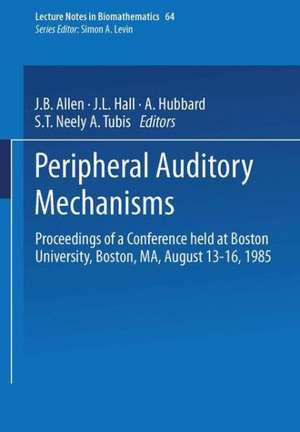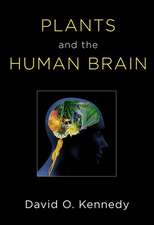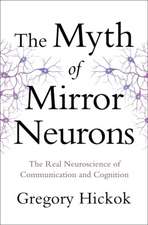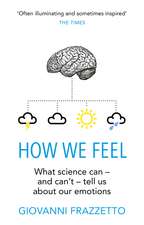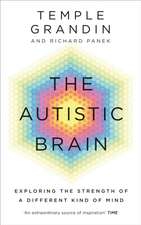Peripheral Auditory Mechanisms: Proceedings of a conference held at Boston University, Boston, MA, August 13–16, 1985: Lecture Notes in Biomathematics, cartea 64
Editat de J.B. Allen, J.L. Hall, A. Hubbard, S.T. Neely, A. Tubisen Limba Engleză Paperback – mar 1986
Din seria Lecture Notes in Biomathematics
-
 Preț: 378.54 lei
Preț: 378.54 lei -
 Preț: 380.45 lei
Preț: 380.45 lei -
 Preț: 413.37 lei
Preț: 413.37 lei -
 Preț: 390.63 lei
Preț: 390.63 lei -
 Preț: 396.24 lei
Preț: 396.24 lei -
 Preț: 387.38 lei
Preț: 387.38 lei -
 Preț: 385.08 lei
Preț: 385.08 lei - 5%
 Preț: 366.56 lei
Preț: 366.56 lei -
 Preț: 384.70 lei
Preț: 384.70 lei -
 Preț: 388.13 lei
Preț: 388.13 lei -
 Preț: 394.29 lei
Preț: 394.29 lei - 5%
 Preț: 389.93 lei
Preț: 389.93 lei - 5%
 Preț: 370.74 lei
Preț: 370.74 lei -
 Preț: 384.86 lei
Preț: 384.86 lei -
 Preț: 387.96 lei
Preț: 387.96 lei -
 Preț: 404.29 lei
Preț: 404.29 lei -
 Preț: 391.61 lei
Preț: 391.61 lei -
 Preț: 384.48 lei
Preț: 384.48 lei -
 Preț: 384.48 lei
Preț: 384.48 lei -
 Preț: 383.71 lei
Preț: 383.71 lei -
 Preț: 379.68 lei
Preț: 379.68 lei -
 Preț: 384.09 lei
Preț: 384.09 lei -
 Preț: 405.66 lei
Preț: 405.66 lei -
 Preț: 379.48 lei
Preț: 379.48 lei -
 Preț: 400.65 lei
Preț: 400.65 lei -
 Preț: 385.25 lei
Preț: 385.25 lei -
 Preț: 390.25 lei
Preț: 390.25 lei -
 Preț: 395.47 lei
Preț: 395.47 lei -
 Preț: 378.71 lei
Preț: 378.71 lei -
 Preț: 382.95 lei
Preț: 382.95 lei - 15%
 Preț: 578.01 lei
Preț: 578.01 lei -
 Preț: 380.84 lei
Preț: 380.84 lei -
 Preț: 405.66 lei
Preț: 405.66 lei -
 Preț: 399.12 lei
Preț: 399.12 lei -
 Preț: 410.66 lei
Preț: 410.66 lei -
 Preț: 385.62 lei
Preț: 385.62 lei - 5%
 Preț: 371.10 lei
Preț: 371.10 lei -
 Preț: 378.71 lei
Preț: 378.71 lei -
 Preț: 386.99 lei
Preț: 386.99 lei -
 Preț: 401.61 lei
Preț: 401.61 lei -
 Preț: 350.30 lei
Preț: 350.30 lei -
 Preț: 383.33 lei
Preț: 383.33 lei -
 Preț: 408.54 lei
Preț: 408.54 lei -
 Preț: 398.53 lei
Preț: 398.53 lei -
 Preț: 399.67 lei
Preț: 399.67 lei -
 Preț: 391.79 lei
Preț: 391.79 lei -
 Preț: 384.86 lei
Preț: 384.86 lei -
 Preț: 401.61 lei
Preț: 401.61 lei -
 Preț: 392.60 lei
Preț: 392.60 lei -
 Preț: 406.05 lei
Preț: 406.05 lei
Preț: 398.15 lei
Nou
Puncte Express: 597
Preț estimativ în valută:
76.20€ • 78.71$ • 63.41£
76.20€ • 78.71$ • 63.41£
Carte tipărită la comandă
Livrare economică 25 martie-08 aprilie
Preluare comenzi: 021 569.72.76
Specificații
ISBN-13: 9783540160953
ISBN-10: 3540160957
Pagini: 412
Ilustrații: VII, 402 p.
Dimensiuni: 170 x 244 x 22 mm
Greutate: 0.65 kg
Editura: Springer Berlin, Heidelberg
Colecția Springer
Seria Lecture Notes in Biomathematics
Locul publicării:Berlin, Heidelberg, Germany
ISBN-10: 3540160957
Pagini: 412
Ilustrații: VII, 402 p.
Dimensiuni: 170 x 244 x 22 mm
Greutate: 0.65 kg
Editura: Springer Berlin, Heidelberg
Colecția Springer
Seria Lecture Notes in Biomathematics
Locul publicării:Berlin, Heidelberg, Germany
Public țintă
ResearchCuprins
Outer and Middle Ear Mechanics.- The effectiveness of external and middle ears in coupling acoustic power into the cochlea.- Spatial distribution of sound pressure in the ear canal.- The impulse response vibration of the human ear drum.- Formulation and analysis of a dynamic fiber composite continuum model of the tympanic membrane.- How do contractions of the stapedius muscle alter the acoustic properties of the ear?.- Measurement of eardrum acoustic impedance.- Middle ear research using a SQUID magnetometer. I. Micro- and macromechanical selection of polymer materials for artificial tympanic membranes.- Middle ear research using a SQUID magnetometer. II. Transfer characteristics of human middle ears.- Cochlear Macromechanics.- Cochlear macromechanics — a review.- Transients and speech processing in a three-dimensional model of the human cochlea.- The mechanics of the basilar membrane and middle ear in the pigeon.- On the mechanics of the horseshoe bat cochlea.- Resonance and reflection in the cochlea: the case of the CF-FM bat, Rhinolophus Ferrumequinum.- The complete solution of the basilar membrane condition in two dimensional models of the cochlea.- Longitudinal stiffness coupling in a 1-dimensional model of the peripheral ear.- Mössbauer measurements of the mechanical response to single-tone and two-tone stimuli at the base of the chinchilla cochlea.- Parameter sensitivity in a mathematical model of basilar membrane mechanics.- Cochlear Micromechanics.- Micromechanics of the cochlear partition.- On the role of fluid inertia and viscosity in stereociliary tuft motion: analysis of isolated bodies of regular geometry.- Role of passive mechanical properties of outer hair cells in determination of cochlear mechanics.- Thresholds of auditory sensitivity and auditoryfatigue: relation with cochlear mechanics.- Analysis of streaming flow induced in the tectorial gap.- Active Filtering in the Cochlea.- Active filtering by hair cells.- Determination of the cochlear power flux from basilar membrane vibration data.- An isolated sound emitter in the cochlea: notes on modelling.- Stability of active cochlear models: need for a second tuned structure?.- Changes in spontaneous and evoked otoacoustic emissions and corresponding psychoacoustic threshold microstructures induced by aspirin consumption.- Statistical properties of a strong spontaneous oto-acoustic emission.- The influence of temperature on frequency-tuning mechanisms.- Nonlinear and/or Active Processes.- An overview of nonlinear and active cochlear models.- Evaluating traveling wave characteristics in man by an active nonlinear cochlea preprocessing model.- Modeling intracochlear and ear canal distortion product (2f1-f2).- Interactions among multiple spontaneous otoacoustic emissions.- Basilar membrane motion in guinea pig cochlea exhibits frequency-dependent DC offset.- Linear and nonlinear effects in a physical model of the cochlea.- Modelling the cochlear partition with coupled Van der Pol oscillators.- New effects of cochlear nonlinearity in temporal patterns of auditory nerve fiber responses to harmonic complexes.- Wideband analysis of otoacoustic intermodulation.- Characterization of cubic intermodulation distortion products in the cat external auditory meatus.- Acoustic overstimulation reduces 2f1-f2 cochlear emissions at all levels in the cat.- Harmonic acoustic emissions in the earcanal generated by single tones: experiments and a model.- Steady-state response determination for models of the basilar membrane.- Transduction in the Cochlea.- Transduction in cochlear hair cells.- Furosemide affects ear-canal emissions produced by the injection of AC currents into scala media.- Outer hair cell motility: a possible electro-kinetic mechanism.- Visualization of sensory hair cells in an in vivo preparation.- A model for transduction in hair cells involving strain-activated conductance.- Author index.- Permuted title index.
